Direct Laser Writing of Magneto-Photonic Sub-Microstructures for Prospective Applications in Biomedical Engineering
Abstract
:1. Introduction
2. Synthesis of Magneto-Polymer Composites
3. Realization of Magneto-Photonic Structures by LOPA-Based DLW Technique
3.1. Working Principle of LOPA-Based DLW
3.2. Controlling Structure Size with Exposure Power and Scanning Velocity
3.3. Influence of Structure Period on Structure Size
3.4. Realization of Desired 2D and 3D Magneto-Photonic Structures
4. Reversible Magnetic Field-Driven Motion of Magneto-Photonic Devices
5. Experimental Section
5.1. Magnetite Nanoparticle Preparation
5.2. Elaboration of Magnetic Nanocomposites
5.3. Nanocomposite Thin Film Preparation Process
5.4. Fabrication and Development Procedure of Structures
6. Conclusions
Supplementary Materials
Acknowledgments
Author Contributions
Conflicts of Interest
Appendix A
Appendix A.1. Size and Morphology of the Fe3O4 Nanoparticles
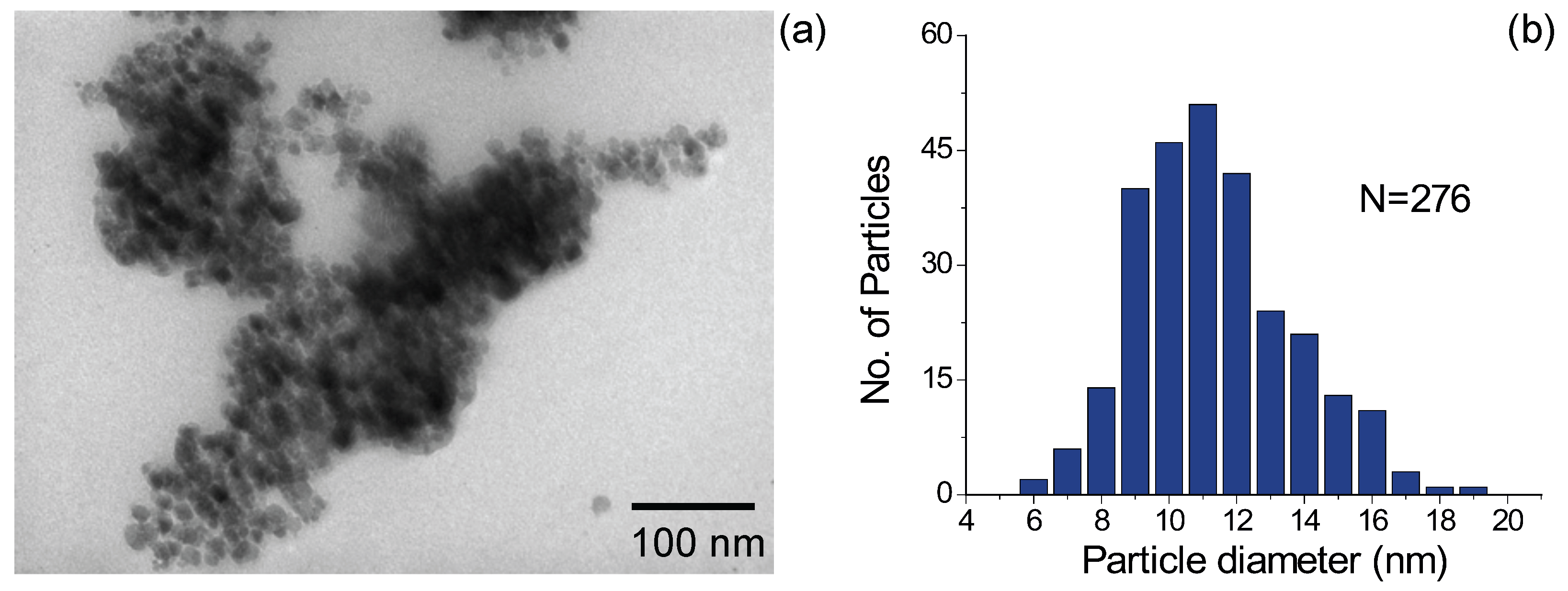
Appendix A.2. Magnetic Characterization of Fe3O4 Nanoparticles
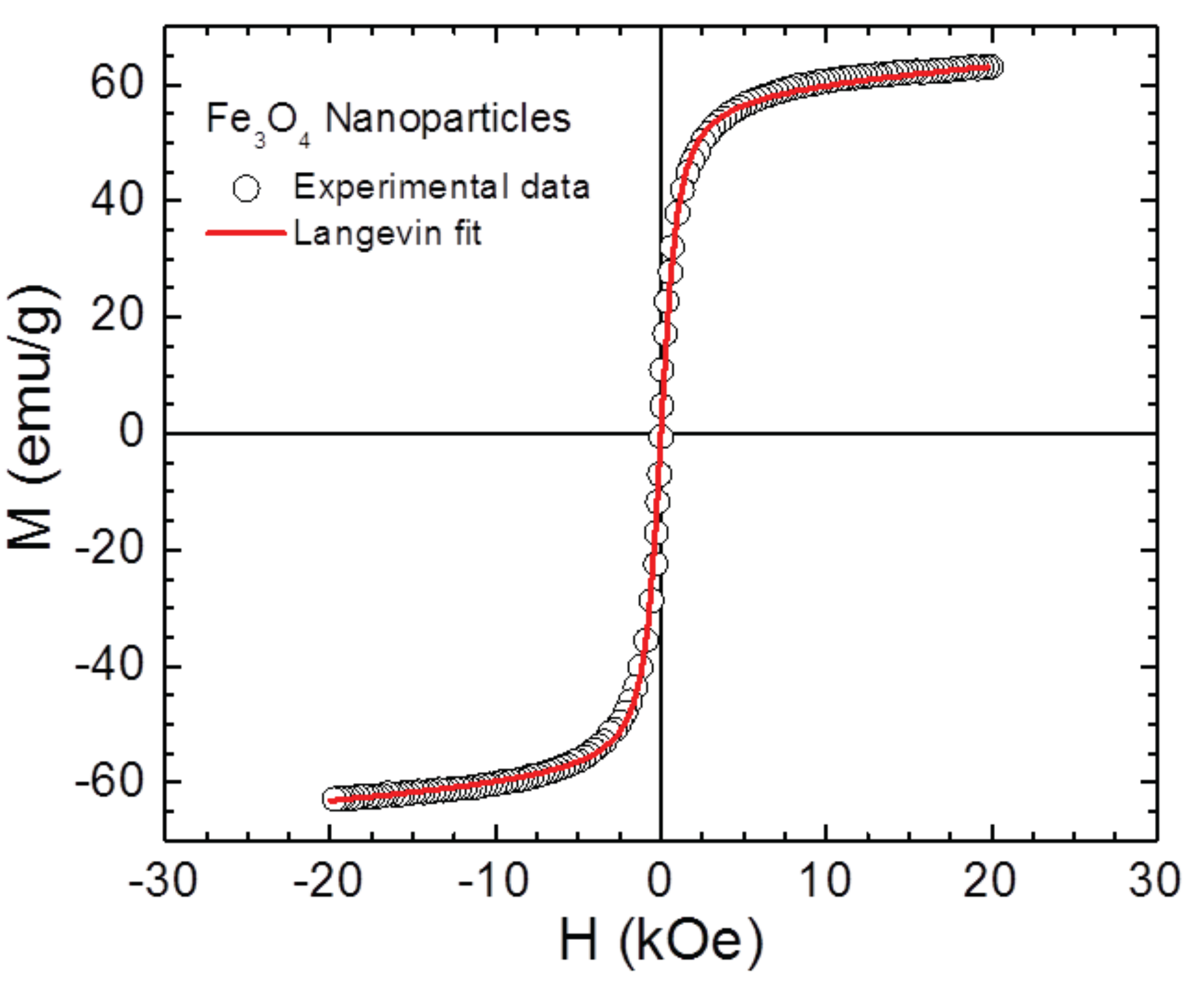
Appendix A.3. Effects of Viscosity and Mixing Time on Dispersion of Fe3O4 Nanoparticles in Polymer
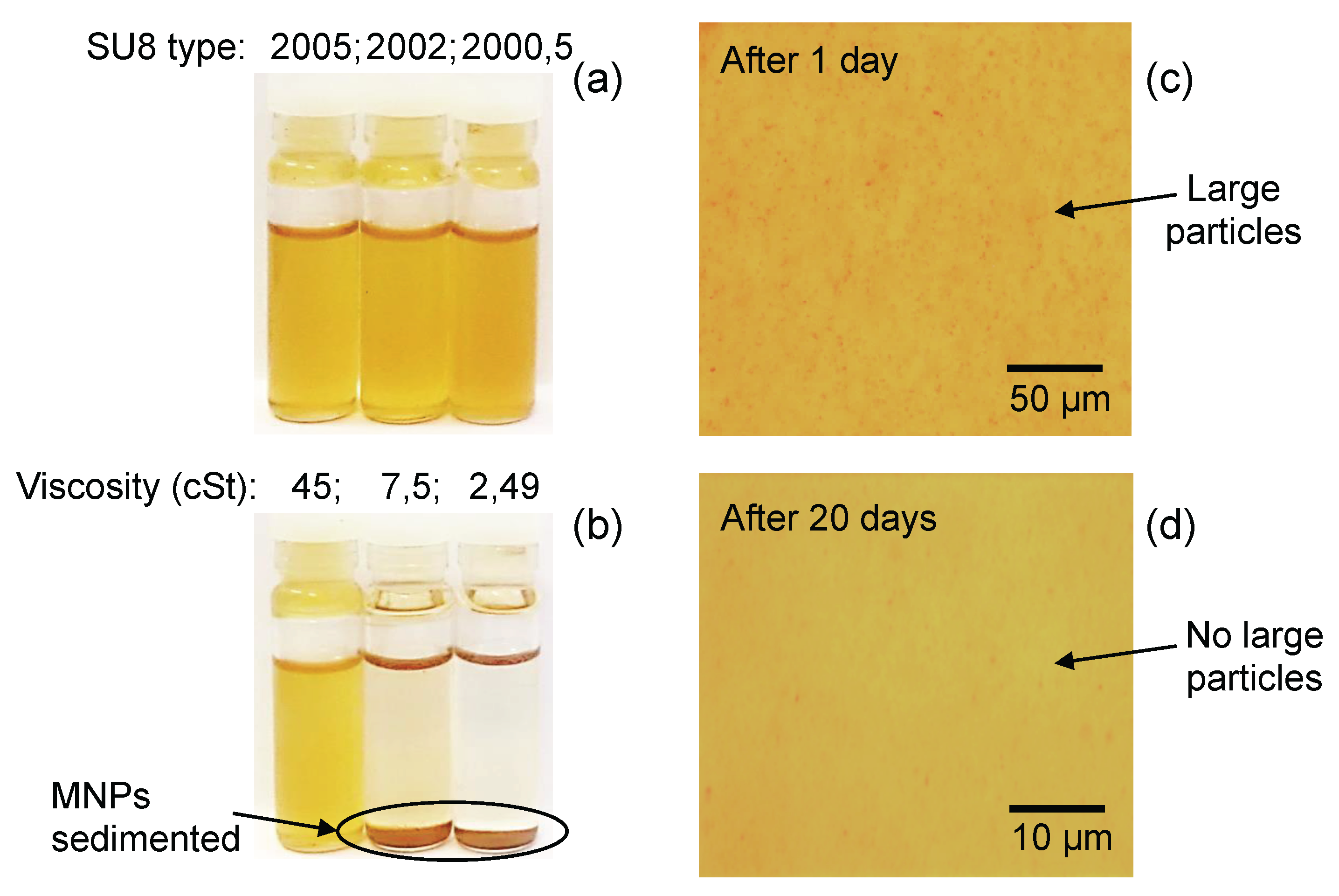
References
- Hu, Y.; Shenderova, O.A.; Hu, Z.; Padgett, C.W.; Brenner, D.W. Carbon nanostructures for advanced composites. Rep. Prog. Phys. 2006, 69, 1847. [Google Scholar] [CrossRef]
- Shukla, S.; Furlani, E.P.; Vidal, X.; Swihart, M.T.; Prasad, P.N. Two-photon lithography of sub-wavelength metallic structures in a polymer matrix. Adv. Mater. 2010, 22, 3695–3699. [Google Scholar] [CrossRef] [PubMed]
- Gordillo, H.; Suárez, I.; Abargues, R.; Rodríguez-Cantó, P.; Albert, S.; Martínez-Pastor, J.P. Polymer/QDs nanocomposites for waveguiding applications. J. Nanomater. 2012, 2012, 960201. [Google Scholar] [CrossRef]
- Gass, J.; Poddar, P.; Almand, J.; Srinath, S.; Srikanth, H. Superparamagnetic Polymer Nanocomposites with Uniform Fe3O4 Nanoparticle Dispersions. Adv. Funct. Mater. 2006, 16, 71–75. [Google Scholar] [CrossRef]
- Li, S.; Qin, J.; Fornara, A.; Toprak, M.; Muhammed, M.; Kim, D.K. Synthesis and magnetic properties of bulk transparent PMMA/Fe-oxide nanocomposites. Nanotechnology 2009, 20, 185607. [Google Scholar] [CrossRef] [PubMed]
- Stojak, K.; Pal, S.; Srikanth, H.; Morales, C.; Dewdney, J.; Weller, T.; Wang, J. Polymer nanocomposites exhibiting magnetically tunable microwave properties. Nanotechnology 2011, 22, 135602. [Google Scholar] [CrossRef] [PubMed]
- Sciancalepore, C.; Bondioli, F.; Messori, M.; Barrera, G.; Tiberto, P.; Allia, P. Epoxy nanocomposites functionalized with in situ generated magnetite nanocrystals: Microstructure, magnetic properties, interaction among magnetic particles. Polymer 2015, 59, 278–289. [Google Scholar] [CrossRef]
- Karaca, E.; Şatır, M.; Kazan, S.; Açıkgöz, M.; Öztürk, E.; Gürdağ, G.; Ulutaş, D. Synthesis, characterization and magnetic properties of Fe3O4 doped chitosan polymer. J. Magn. Magn. Mater. 2015, 373, 53–59. [Google Scholar] [CrossRef]
- Henderson, J.; Shi, S.; Cakmaktepe, S.; Crawford, T.M. Pattern transfer nanomanufacturing using magnetic recording for programmed nanoparticle assembly. Nanotechnology 2012, 23, 185304. [Google Scholar] [CrossRef] [PubMed]
- Cui, Z.; Rothman, J.; Klaui, M.; Lopez-Diaz, L.; Vaz, C.A.F.; Bland, J.A.C. Fabrication of magnetic rings for high density memory devices. Microelectron. Eng. 2002, 61–62, 577–583. [Google Scholar] [CrossRef]
- Alfadhel, A.; Li, B.; Kosel, J. Magnetic polymer nanocomposites for sensing applications. In Proceedings of the IEEE SENSORS 2014, At Valencia, Spain, 2–5 November 2014; pp. 2066–2069. [Google Scholar]
- Kim, J.; Chung, S.E.; Choi, S.E.; Lee, H.; Kim, J.; Kwon, S. Programming magnetic anisotropy in polymeric microactuators. Nat. Mater. 2011, 10, 747–752. [Google Scholar] [CrossRef] [PubMed]
- Safarik, I.; Safarikova, M. Magnetic techniques for the isolation and purification of proteins and peptides. BioMagn. Res. Technol. 2004, 2, 7. [Google Scholar] [CrossRef] [PubMed]
- Xue, X.; Wang, J.; Furlani, E.P. Self-assembly of crystalline structures of magnetic core–shell nanoparticles for fabrication of nanostructured materials. ACS Appl. Mater. Interfaces 2015, 7, 22515–22524. [Google Scholar] [CrossRef] [PubMed]
- Velez, C.; Torres-Díaz, I.; Maldonado-Camargo, L.; Rinaldi, C.; Arnold, D.P. Magnetic assembly and cross-linking of nanoparticles for releasable magnetic microstructures. ACS Nano 2015, 9, 10165–10172. [Google Scholar] [CrossRef] [PubMed]
- Yan, X.; Zhou, Q.; Yu, J.; Xu, T.; Deng, Y.; Tang, T.; Feng, Q.; Bian, L.; Zhang, Y.; Ferreira, A.; et al. Magnetite nanostructured porous hollow helical microswimmers for targeted delivery. Adv. Funct. Mater. 2015, 25, 5333–5342. [Google Scholar] [CrossRef]
- Jacot-Descombes, L.; Gullo, M.R.; Cadarso, V.J.; Mastrangeli, M.; Ergeneman, O.; Peters, C.; Fatio, P.; Freidy, M.A.; Hierold, C.; Nelson, B.J.; et al. Inkjet printing of high aspect ratio superparamagnetic SU-8 microstructures with preferential magnetic directions. Micromachines 2014, 5, 583–593. [Google Scholar] [CrossRef]
- Suh, S.K.; Yuet, K.; Hwang, D.K.; Bong, K.W.; Doyle, P.S.; Hatton, T.A. Synthesis of nonspherical superparamagnetic particles: In situ coprecipitation of magnetic nanoparticles in microgels prepared by stop-flow lithography. J. Am. Chem. Soc. 2012, 134, 7337–7343. [Google Scholar] [CrossRef] [PubMed]
- Nelson, B.J.; Kaliakatsos, I.K.; Abbott, J.J. Microrobots for minimally invasive medicine. Annu. Rev. Biomed. Eng. 2010, 12, 55–85. [Google Scholar] [CrossRef] [PubMed]
- Patra, S.; Roy, E.; Karfa, P.; Kumar, S.; Madhuri, R.; Sharma, P.K. Dual-responsive polymer coated superparamagnetic nanoparticle for targeted drug delivery and hyperthermia treatment. ACS Appl. Mater. Interfaces 2015, 7, 9235–9246. [Google Scholar] [CrossRef] [PubMed]
- Peyer, K.E.; Zhang, L.; Nelson, B.J. Bio-inspired magnetic swimming microrobots for biomedical applications. Nanoscale 2013, 5, 1259–1272. [Google Scholar] [CrossRef] [PubMed]
- Sekkat, Z.; Kawata, S. Laser nanofabrication in photoresists and azopolymers. Laser Photonics Rev. 2014, 8, 1–26. [Google Scholar] [CrossRef]
- Hohmann, J.K.; Renner, M.; Waller, E.H.; von Freymann, G. Three-dimensional micro-printing: An enabling technology. Adv. Opt. Mater. 2015, 3, 1488–1507. [Google Scholar] [CrossRef]
- Tottori, S.; Zhang, L.; Qiu, F.; Krawczyk, K.K.; Franco-Obregón, A.; Nelson, B.J. Magnetic helical micromachines: Fabrication, controlled swimming, and cargo transport. Adv. Mater. 2012, 24, 811–816. [Google Scholar] [CrossRef] [PubMed]
- Peters, C.; Ergeneman, O.; García, P.D.W.; Müller, M.; Pané, S.; Nelson, B.J.; Hierold, C. Superparamagnetic twist-type actuators with shape-Independent magnetic properties and surface functionalization for advanced biomedical applications. Adv. Funct. Mater. 2014, 24, 5269–5276. [Google Scholar] [CrossRef]
- Do, M.T.; Nguyen, T.T.N.; Li, Q.; Benisty, H.; Ledoux-Rak, I.; Lai, N.D. Submicrometer 3D structures fabrication enabled by one-photon absorption direct laser writing. Opt. Express 2013, 21, 20964–20973. [Google Scholar] [CrossRef] [PubMed]
- Li, Q.; Do, M.; Ledoux-Rak, I.; Lai, N.D. Concept for three-dimensional optical addressing by ultralow one-photon absorption method. Opt. Lett. 2013, 38, 4640–4643. [Google Scholar] [CrossRef] [PubMed]
- Zheng, X.; Zhu, Q.; Song, H.; Zhao, X.; Yi, T.; Chen, H.; Chen, X. In situ synthesis of self-assembled three-dimensional graphene-magnetic palladium nanohybrids with dual-enzyme activity through one-pot strategy and its application in glucose probe. ACS Appl. Mater. Interfaces 2015, 7, 3480–3491. [Google Scholar] [PubMed]
- Walker, D.A.; Kowalczyk, B.; Olvera de la Cruzabc, M.; Grzybowski, B.A. Electrostatics at the nanoscale. Nanoscale 2011, 3, 1316–1344. [Google Scholar] [CrossRef] [PubMed]
- Beketov, I.V.; Safronov, A.P.; Medvedev, A.I.; Alonso, J.; Kurlyandskaya, G.V.; Bhagat, S.M. Iron oxide nanoparticles fabricated by electric explosion of wire: Focus on magnetic nanofluids. AIP Adv. 2012, 2, 022154. [Google Scholar] [CrossRef]
- Yan, L.T.; Xie, X.M. Computational modeling and simulation of nanoparticle self-assembly in polymeric systems: Structures, properties and external field effects. Prog. Polym. Sci. 2013, 38, 369–405. [Google Scholar] [CrossRef]
- Bleach, R.; Karagoz, B.; Prakash, S.M.; Davis, T.P.; Boyer, C. In Situ Formation of Polymer-Gold Composite Nanoparticles with Tunable Morphologies. ACS Macro Lett. 2014, 3, 591–596. [Google Scholar] [CrossRef]
- Kurlyandskaya, G.V.; Safronov, A.P.; Bhagat, S.M.; Lofland, S.E.; Beketov, I.V.; Marcano Prieto, L. Tailoring functional properties of Ni nanoparticles-acrylic copolymer composites with different concentrations of magnetic filler. J. Appl. Phys. 2015, 117, 123917. [Google Scholar] [CrossRef]
- Do, M.T.; Li, Q.; Ledoux-Rak, I.; Lai, N.D. Optimization of LOPA-based direct laser writing technique for fabrication of submicrometric polymer two- and three-dimensional structures. SPIE Proc. 2014, 9127. [Google Scholar] [CrossRef]
- Nguyen, T.T.N.; Tong, Q.C.; Ledoux-Rak, I.; Lai, N.D. One-step fabrication of submicrostructures by low one-photon absorption direct laser writing technique with local thermal effect. J. Appl. Phys. 2016, 119, 013101. [Google Scholar] [CrossRef]
- Markides, H.; Rotherham, M.; El Haj, A.J.; Markides, H.; Rotherham, M.; El Haj, A.J. Biocompatibility and toxicity of magnetic nanoparticles in regenerative medicine, biocompatibility and toxicity of magnetic nanoparticles in regenerative medicine. J. Nanomater. 2012, 2012, 614094. [Google Scholar] [CrossRef]
- Phan, M.H.; Alonso, J.; Khurshid, H.; Lampen-Kelley, P.; Chandra, S.; Repa, K.S.; Nemati, Z.; Das, R.; Iglesias, O.; Srikanth, H. Exchange Bias Effects in Iron Oxide-Based Nanoparticle Systems. Nanomaterials 2016, 6, 221. [Google Scholar] [CrossRef] [PubMed]
- Allia, P.; Coisson, M.; Spizzo, F.; Tiberto, P.; Vinai, F. Magnetic correlation states in cosputtered granular Ag100-xFex films. Phys. Rev. B 2006, 73, 054409. [Google Scholar] [CrossRef]
- Stojak-Repa, K.; Israel, D.; Alonso, J.; Phan, M.H.; Palmero, E.M.; Vazquez, M.; Srikanth, H. Superparamagnetic properties of carbon nanotubes filled with NiFe2O4 nanoparticles. J. Appl. Phys. 2015, 117, 17C723. [Google Scholar] [CrossRef]
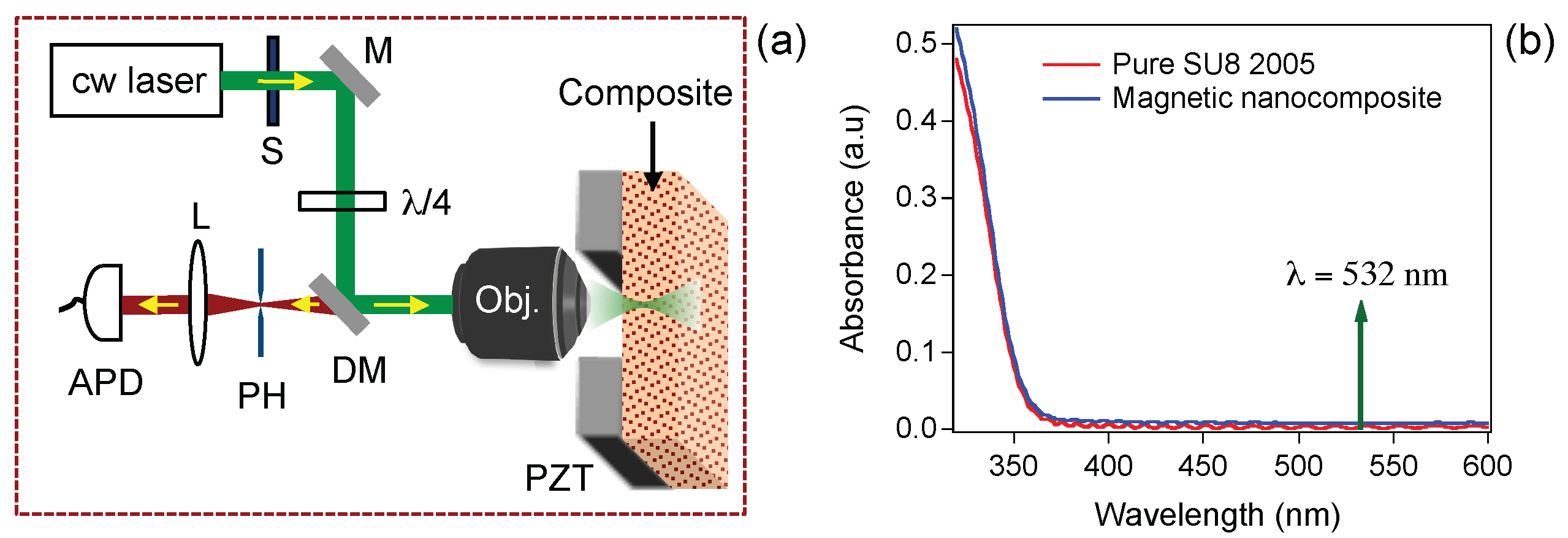
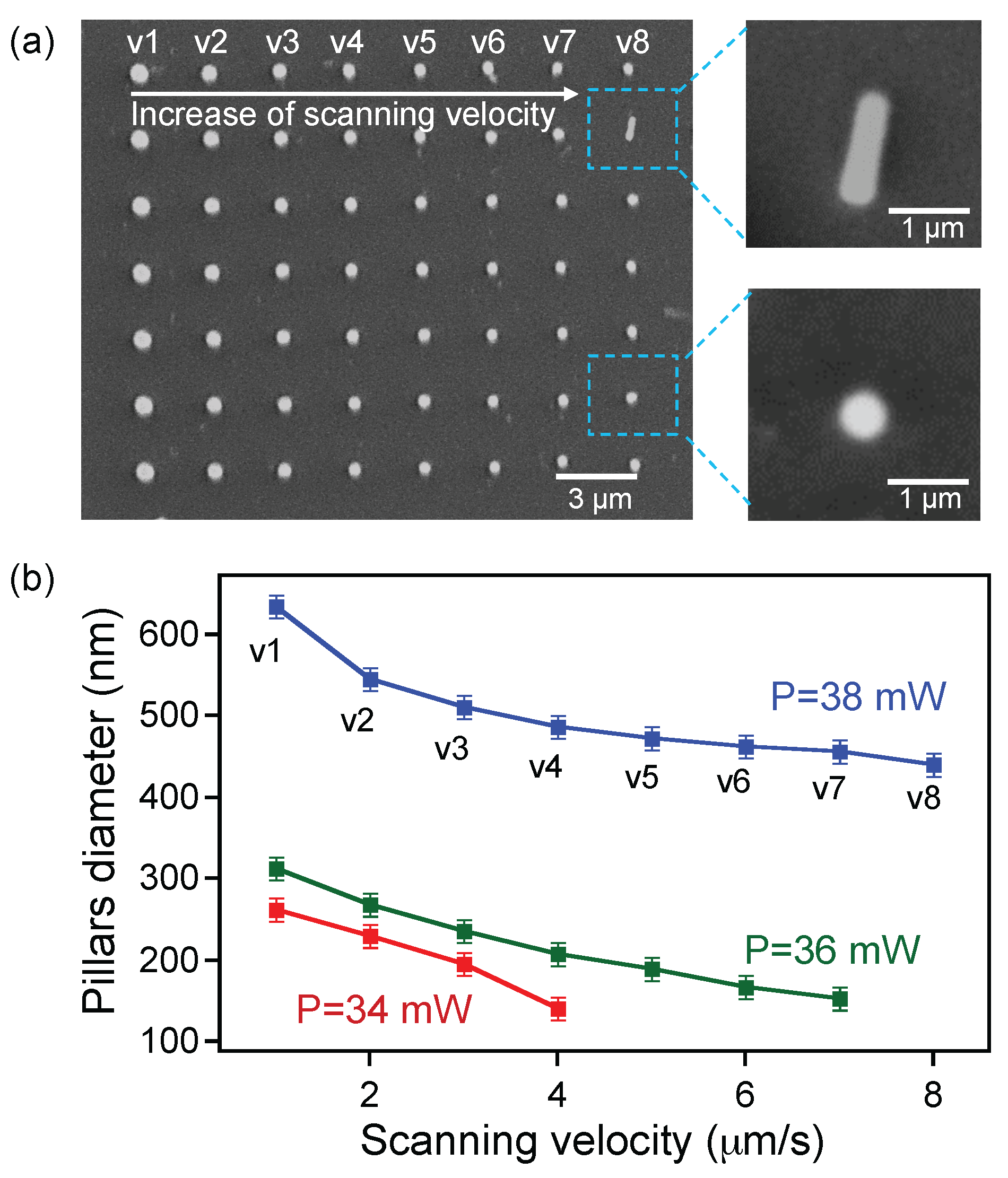
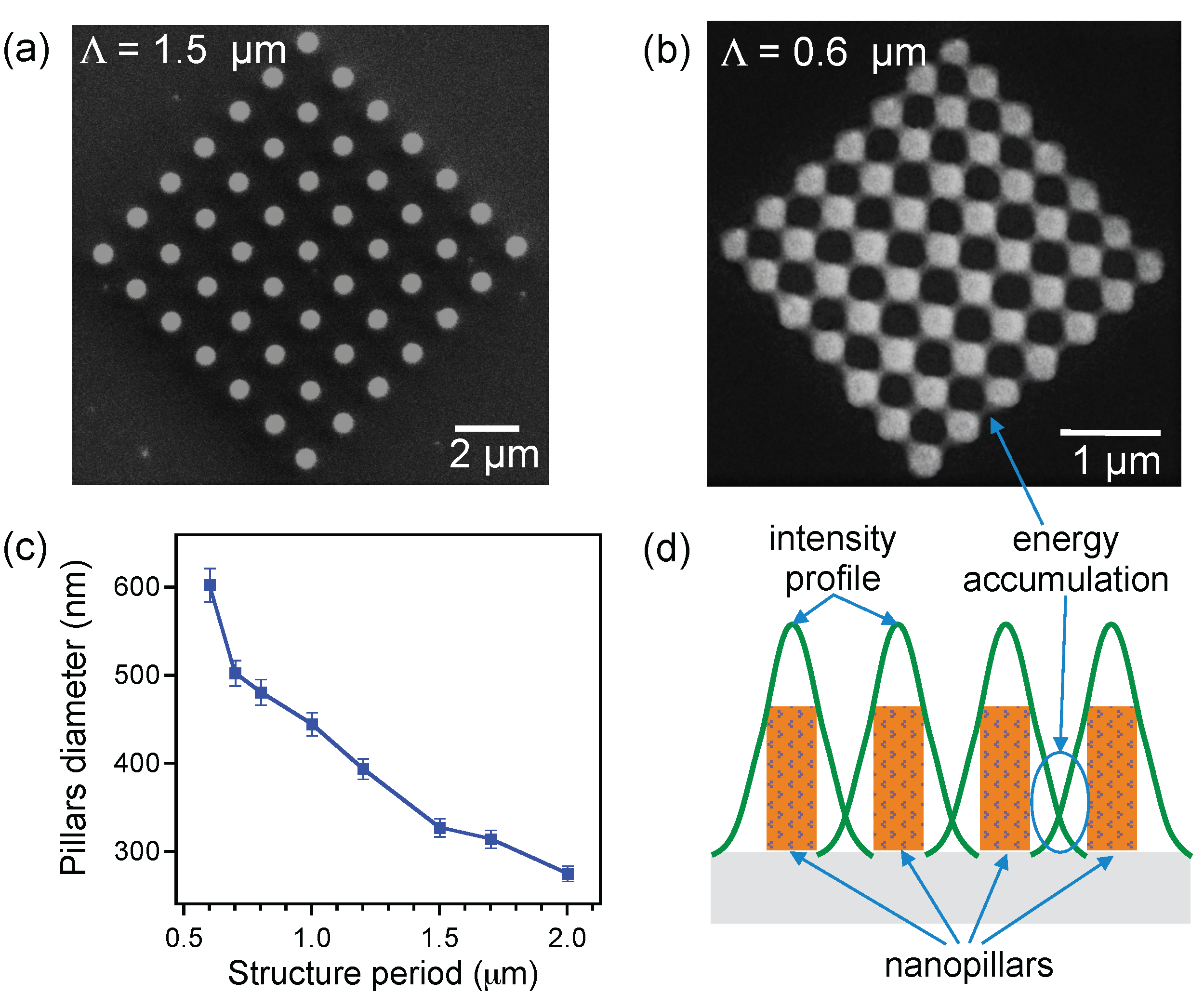
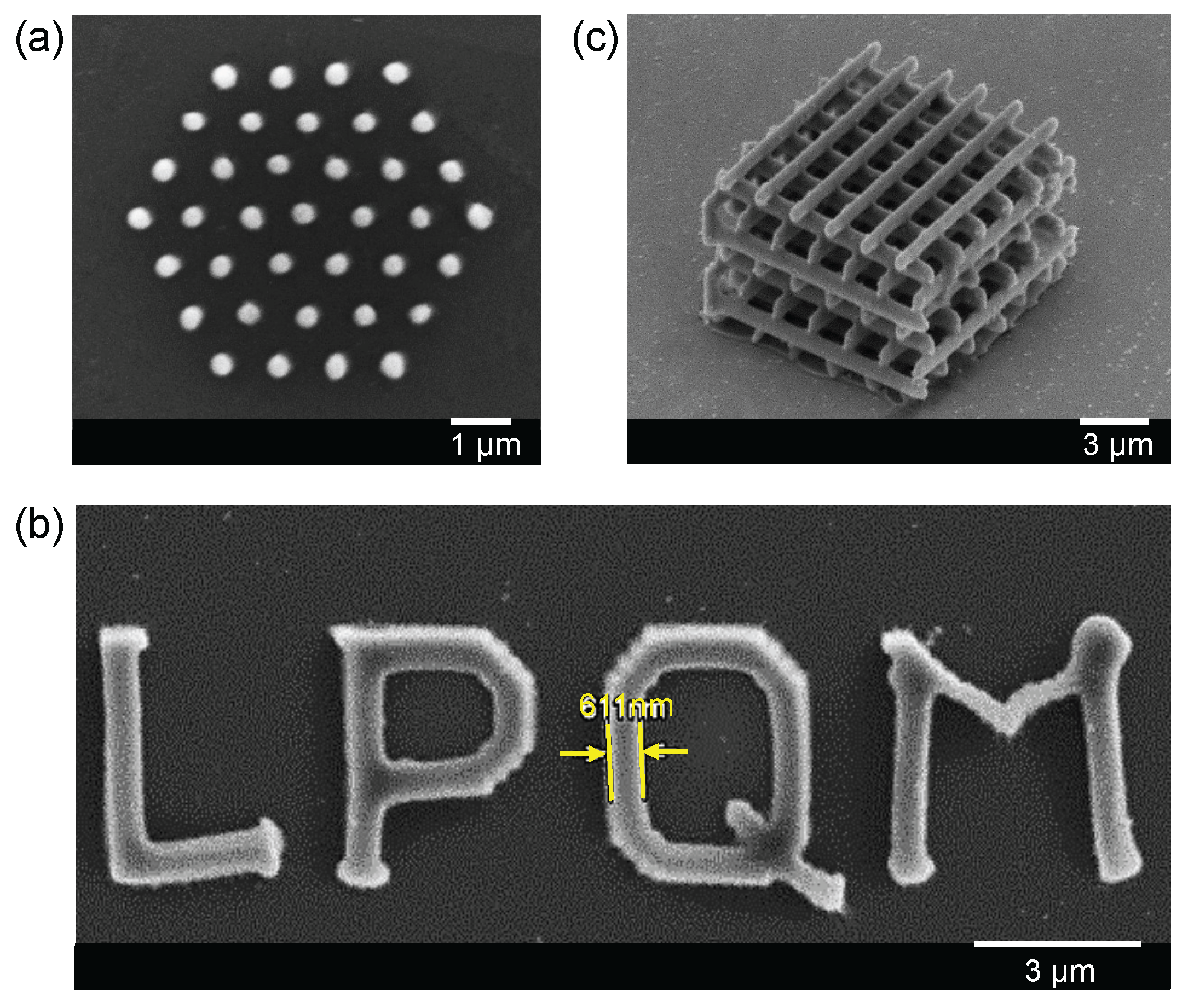
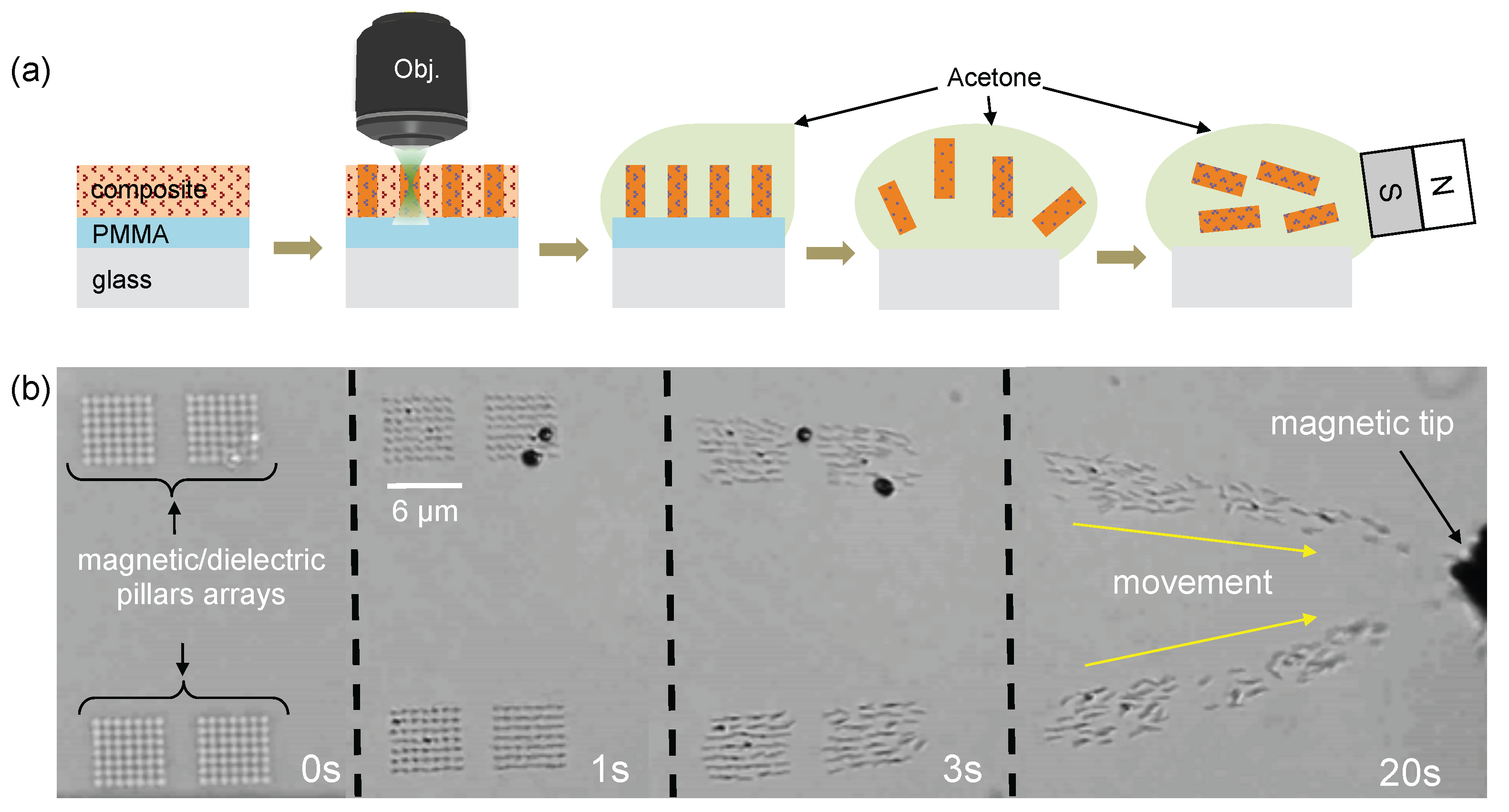
© 2017 by the authors. Licensee MDPI, Basel, Switzerland. This article is an open access article distributed under the terms and conditions of the Creative Commons Attribution (CC BY) license (http://creativecommons.org/licenses/by/4.0/).
Share and Cite
Au, T.H.; Trinh, D.T.; Tong, Q.C.; Do, D.B.; Nguyen, D.P.; Phan, M.-H.; Lai, N.D. Direct Laser Writing of Magneto-Photonic Sub-Microstructures for Prospective Applications in Biomedical Engineering. Nanomaterials 2017, 7, 105. https://doi.org/10.3390/nano7050105
Au TH, Trinh DT, Tong QC, Do DB, Nguyen DP, Phan M-H, Lai ND. Direct Laser Writing of Magneto-Photonic Sub-Microstructures for Prospective Applications in Biomedical Engineering. Nanomaterials. 2017; 7(5):105. https://doi.org/10.3390/nano7050105
Chicago/Turabian StyleAu, Thi Huong, Duc Thien Trinh, Quang Cong Tong, Danh Bich Do, Dang Phu Nguyen, Manh-Huong Phan, and Ngoc Diep Lai. 2017. "Direct Laser Writing of Magneto-Photonic Sub-Microstructures for Prospective Applications in Biomedical Engineering" Nanomaterials 7, no. 5: 105. https://doi.org/10.3390/nano7050105
APA StyleAu, T. H., Trinh, D. T., Tong, Q. C., Do, D. B., Nguyen, D. P., Phan, M.-H., & Lai, N. D. (2017). Direct Laser Writing of Magneto-Photonic Sub-Microstructures for Prospective Applications in Biomedical Engineering. Nanomaterials, 7(5), 105. https://doi.org/10.3390/nano7050105






